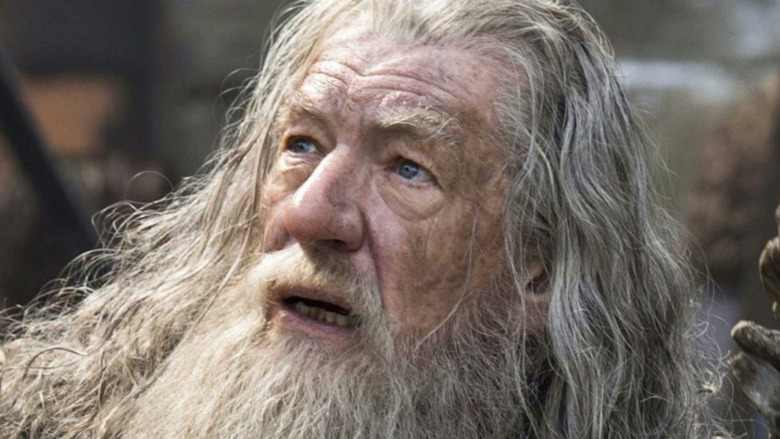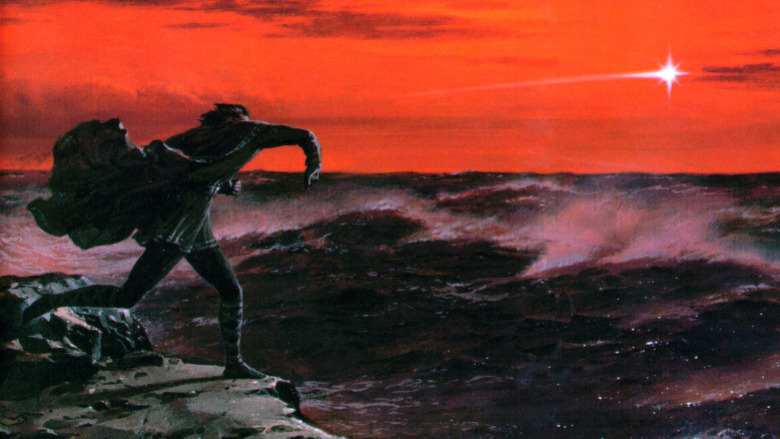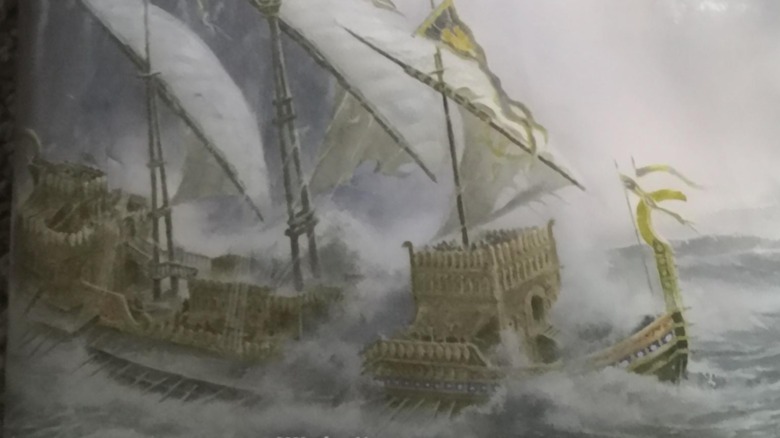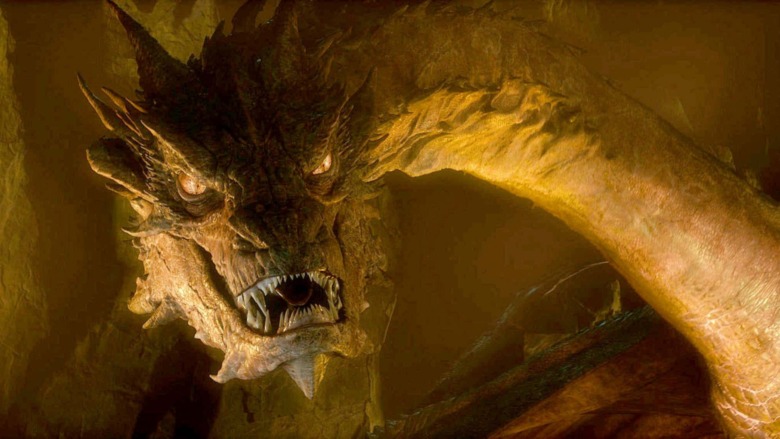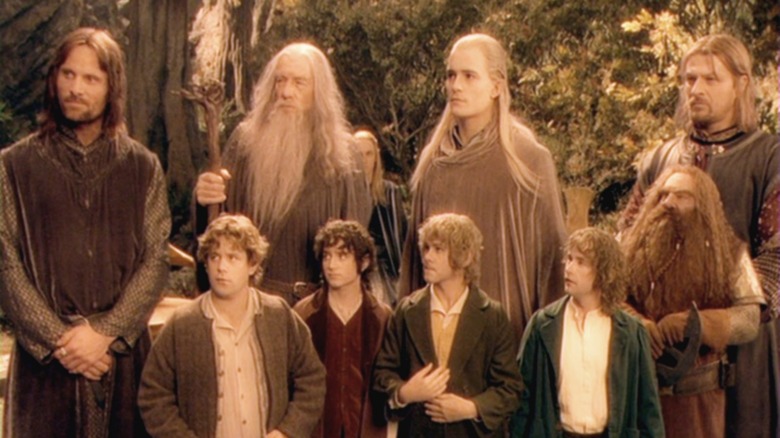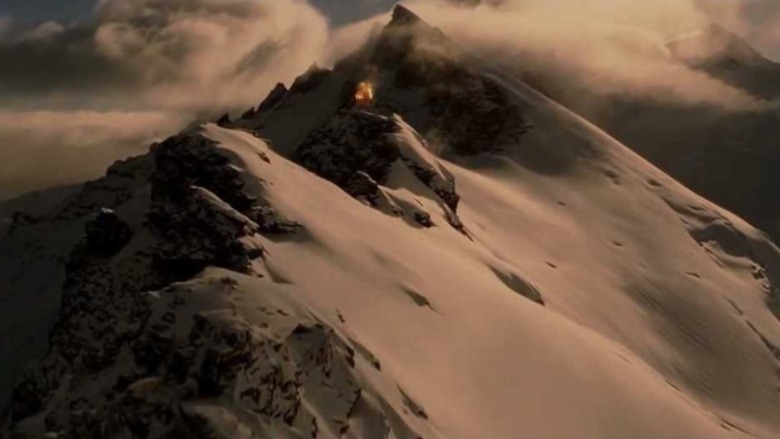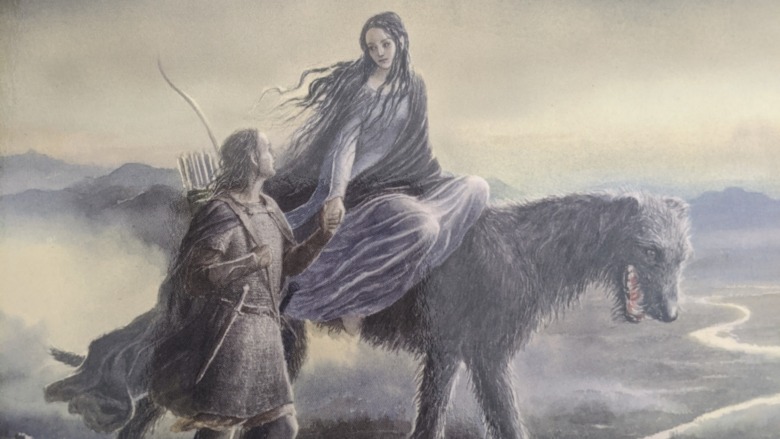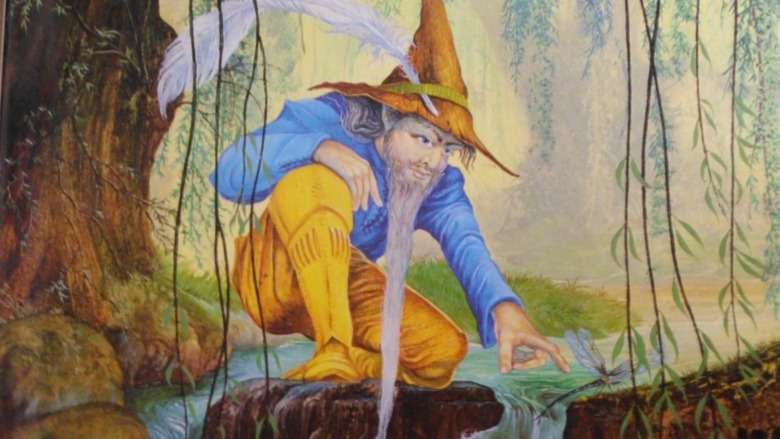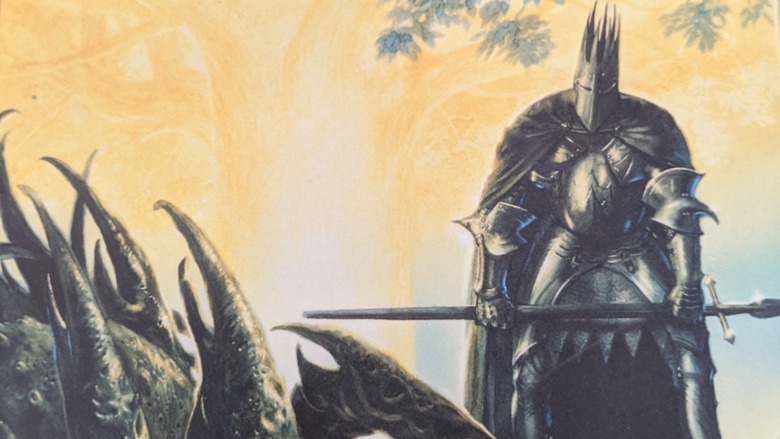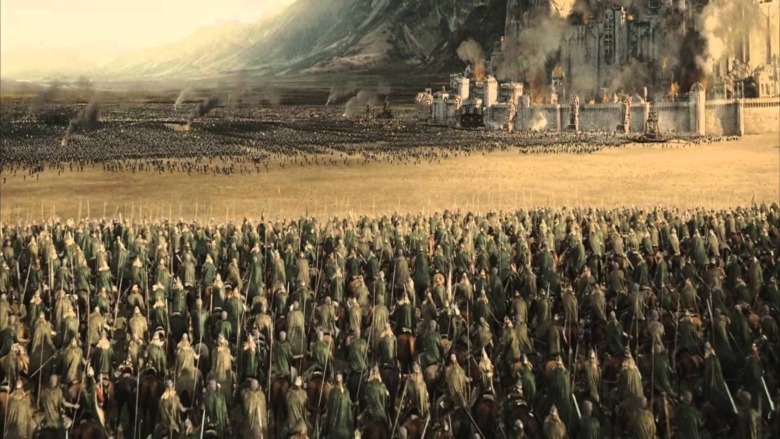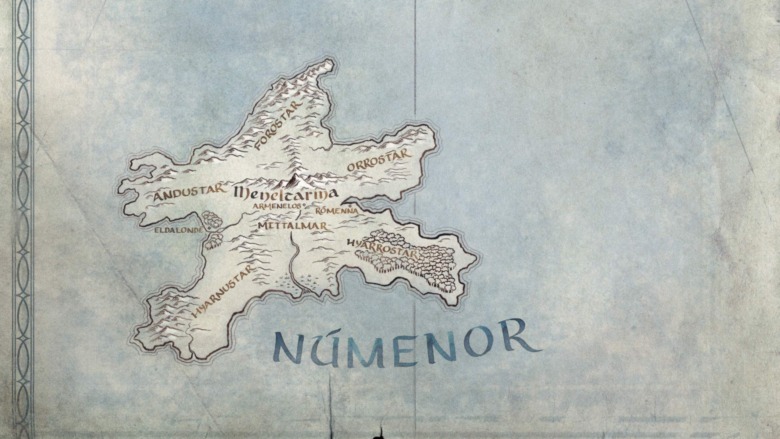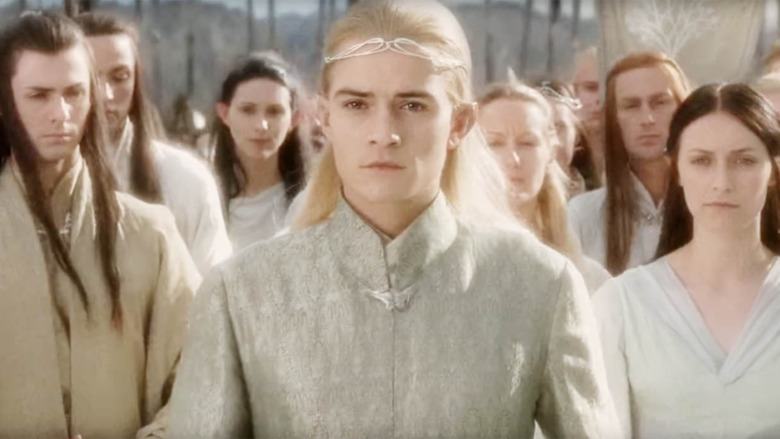Middle-Earth Media You Should Consume Before Watching Amazon's Lord Of The Rings Prequel
In late 2017, the news broke that Amazon had purchased the rights to J.R.R. Tolkien's The Lord of the Rings. It was eventually revealed that the studio probably won't be dabbling in the famed War of the Ring much, if at all. Instead, the company paid a pretty penny to make an enormously expensive streaming series based on the Second Age of Middle-earth history.
For those of you counting at home, both The Hobbit and The Lord of the Rings take place at the end of the 3,000-year-long Third Age. The Second Age that precedes it is even longer, by a few centuries. That means a story taking place early in the Second Age could be set as many as 6,000 years before Frodo leaves Bag End on his quest. With such an enormous time gap involved, fans got busy wondering what, exactly, the Amazon series will cover. With an author like Tolkien involved, the answer is a lot. Like, a heck of a lot.
Luckily, there are numerous resources created by Tolkien and his admirers that can shed some light on the era the Amazon series tackles. We've collected all of the most important Middle-earth media that can help fans prepare for the show. Some of these entries should be watched or read before enjoying the new series. Others are worth having nearby while watching it. Either way, each and every one of them represents an awesome facet of Middle-earth lore.
The Silmarillion
The Silmarillion is the driving force behind all of Tolkien's Middle-earth creations. In the preface to The Fellowship of the Ring, the beloved author explains that he started this massive historical compendium in order to "provide the necessary background of 'history' for Elvish tongues." In other words, the man was literally making up an entire world as a setting for the language he was developing, in what surely stands as one of the coolest accomplishments in the history of the fantasy genre.
The Silmarillion certainly holds up to the epic hype. The book traces Middle-earth's history from its creation through the First, Second, and Third Ages, with a primary focus on the First Age. However, a significant portion of the end of the book is dedicated to the Second Age. Within that is a section called "Akallabêth," which is subtitled "The Downfall of Númenor." This is the insane tale of a nation of men who live on the island of Númenor, off the coast of Middle-earth. It's the backbone of the Second Age's mythology, and is very likely going to be a key factor in Amazon's show. Even if the rest of The Silmarillion is too dense for passing fans, "Akallabêth" is at least worth a read, if only to help set the stage for the larger-than-life events of the series.
Unfinished Tales
Unfinished Tales offers a wonderfully disjointed stroll through several different aspects of Middle-earth lore. Compiled by Christopher Tolkien after the death of his father, Unfinished Tales covers a plethora of different topics. The book has entire portions devoted to, among other things, multiple First Age heroes, the magical Seeing Stones known as the palantíri, the background of the wizards, and the Wild Men of the Woods called the Drúedain. It also outlines missing pieces of the Middle-earth narrative, such as the Black Riders' hunt for the Ring, the founding of Rohan, and how Théoden's son is killed by Saruman's Uruk-hai.
All of this is reason enough to give the book a read. However, when it comes to Amazon's show, Unfinished Tales is especially relevant. Of particular note are three chapters. "A Description of the Island of Númenor" gives a detailed breakdown of the island nation that will likely be a huge part of the show. "Aldarion and Erendis: The Mariner's Wife" is a heartbreaking love story that follows one of the royal couples of Númenor. Finally, "The Line of Elros: Kings of Númenor" traces a line of kings that happens to end with none other than Aragorn himself. If you want a solid grasp of the incredible events Amazon has to work with, these chapters need to be in your pre-viewing itinerary.
The Hobbit (book version)
We've got to include The Hobbit, if for no other reason than because it's ground zero for the Tolkien experience. Even if you've watched Peter Jackson's films or read The Lord of the Rings trilogy already, you need to back up and give The Hobbit a read. If you've watched the movies by the same name, that's even more reason to read the book, since it's a gazillion times better. In comparison to the book, the movies are like butter scraped over too much bread.
The truth is, most aspects of The Hobbit won't directly relate to a show set in the Second Age. Sure, Elrond is in Rivendell and Sauron lurks on the edge of the story as the Necromancer. And, of course, the One Ring is involved too. For the most part, though, The Hobbit is a self-contained story — and that's why we've got it on this list.
Most of Tolkien's writings are extremely complex, convoluted, and high-minded. However, he wrote The Hobbit with his kids in mind. As such, the book is more accessible than practically any other piece of Middle-earth material. It's a great way to dip your toes into the vast, deep, and turbulent ocean that is Tolkien's legendarium before Amazon takes us 6,000 years into the past.
The Lord of the Rings (book version)
The Lord of the Rings is made up of three books: The Fellowship of the Ring, The Two Towers, and The Return of the King. This trilogy is the bedrock upon which modern fantasy is built: Reading it is an experience that every fan of the genre should attempt before they die.
That said, what makes reading these books good preparation for the Amazon show? Good question. The Lord of the Rings is, in many ways, the perfect stepping stone from the childlike experience of reading The Hobbit on up to the headier matters of Middle-earth legend. It maintains a Hobbit-like approach to the story, telling the tale largely through the eyes of Samwise Gamgee, Peregrin Took, Meriadoc Brandybuck, and, of course, Bilbo's younger cousin, Frodo.
While The Lord of the Rings takes an innocent approach, its quartet of Hobbit adventurers run into a boatload of characters, items, and places that have been around since the Second Age. Collectively, they hobnob with Tom Bombadil, join forces with Treebeard, travel across the Dead Marshes, see the White Tree of Gondor, use a palantír, tread the paths of Lothlórien, and trudge through Moria, among other experiences. The number of callbacks to the Second Age and beyond contained within the classic trilogy makes reading it a pre-viewing necessity.
The Lord of the Rings and The Hobbit (the movies)
Including both The Lord of the Rings and The Hobbit films may seem strange, since the book versions of these Third Age stories are already on this list. But our motivation in including the movies is different: We're focused on the visual setting of all six films.
Peter Jackson's hexad of films take place in an interconnected universe. They all have the same epic flair, similar cinematography, and a consistent setting provided by New Zealand. Given the films' iconic status, there's a good chance that Amazon's iteration of Middle-earth will draw from them — whether it's technically connected to Jackson's adaptations or not.
That said, it's also worth throwing certain older adaptations into the mix. A cartoon version of The Hobbit debuted in 1977, and was followed by an animated version of The Lord of the Rings the following year. There are also several fan films worth checking out, including The Hunt for Gollum, Born of Hope, and Horn of Gondor. Heck, there's even a long-lost Russian adaptation out there, if you're looking to take in all the sights.
Beren and Lúthien, The Children of Hurin, and The Fall of Gondolin
The Silmarillion is largely driven by a sweeping chronological account of Middle-earth's very long history. However, there are several points where the narrative slows down to a crawl to recount particular tales. Three of the best of these tales are Beren and Lúthien, The Children of Húrin, and The Fall of Gondolin. All three of these stories are presented in incomplete form in The Silmarillion itself. However, Tolkien had plans to write them as stand-alone stories. After his death, his son Christopher cobbled together his notes and created the closest thing to complete versions of each.
While they all take place in the First Age, these tales have massive repercussions that influence the Second Age as well. These stories establish, among other things, the kingly line of Númenor, Elrond's lineage, and the downfall of Sauron's original master, Morgoth — an event that launches Sauron himself into the dictatorial hot seat. While none of these tales are required reading, they seriously flesh out the background of the show. Their book incarnations are also a more digestible format than the truncated versions of The Silmarillion, which is always a plus.
The Adventures of Tom Bombadil
Anyone looking for a fun trip off the beaten path of Middle-earth material need look no further than the merry little publication called The Adventures of Tom Bombadil and Other Verses from the Red Book. This miniature tale primarily consists of a pair of poetic stories named after the enigmatic Tom Bombadil.
Tolkien's larger-than-life character provides a wonderful break from other Middle-earth stories' potent subject matter. These poems follow a light-hearted, superpowered character who hangs around on the outskirts of the larger story. Fans of the books know Tom and his wife Goldberry well, as they show up early in The Fellowship of the Ring. While he was left out of Peter Jackson's films, Bombadil is older than the hills — which means he might show up in Amazon's series.
Beyond Bombadil, this little book also includes several other poems, many of which touch upon various points in Middle-earth history. While it lacks the gravitas of so many of Tolkien's other writings, it's that very sense of lightness and frivolity that makes The Adventures of Tom Bombadil such a fun read.
The Letters of J.R.R. Tolkien and The History of Middle-earth
These two publications are definitely the deepest, nerdiest, and most over-the-top on this list. The first is The Letters of J.R.R. Tolkien. This academic compilation consists of over 350 letters that span the Oxford don's time as an undergrad to mere days before his death. Letters isn't the kind of book you read cover to cover. However, it functions really well as a sort of Tolkien handbook — especially since it comes with an index that allows readers to look up Tolkien's informal thoughts on an endless variety of different Middle-earth subjects. Moreover, many of the letters are written to either his publishers or devoted fans, and they make for some fun extracurricular reading.
The other truly exhaustive recommendation we have to offer is The History of Middle-earth. For those who are genuinely head over heels for all things Tolkien, this 12-volume series is about as overwhelmingly Tolkienian as it gets. Each of the dozen books included presents different facets of Tolkien's lifelong development of Middle-earth, including oodles of content on the formation of the Second Age. Once again, this isn't a cover to cover experience, but rather a set that's worth having on hand as odd names, eras, and languages drop in the new series.
Howard Shore's soundtracks
This list is littered with books, movies, animations, letters, poems, and other forms of media for the curious fan to devour. This material paves the way for the best experience for fans, once they finally grab their popcorn and settle in to stream the Amazon show. One form of media you might not expect to be essential to the preparatory experience, though, is music. Enter Howard Shore's mesmerizingly beautiful soundtracks.
Shore's compositions are an iconic part of Jackson's films. They provide the perfect backdrop as the movies move from the calm atmosphere of the Shire on to mythic Elvish strongholds, subterranean Dwarvish kingdoms, ancient cities of men, and the dire landscape of Mordor itself. There are few elements of Jackson's adaptations that are more nostalgic than Shore's soundtracks, as is attested to by the Academy Awards Shore won for them.
These soundtracks may not provide crucial information. Heck, they don't really provide any information at all. And yet, few would argue that listening through a LOTR playlist a few times isn't the perfect way to get into a good headspace before binging the new series.
Amazon's map
The bulk of the recommendations on this list are worth consuming before experiencing the show. However, there are also a few resources that are well worth having on hand while watching the show. One of these is a quality map of Middle-earth. Fortunately, there's an excellent (and free) map available, to help any fan make sense of where the heck the characters are. In fact, this Middle-earth resource isn't just helpful in processing the landscape and locations of Amazon's Middle-earth — it's actually a map created by the studio itself.
Early on in the production process, Amazon set up social media accounts associated with the hashtag #LOTRonPrime. One of the first things they used these for was to release a series of high-resolution maps of Middle-earth. They began blank, and were slowly filled in with various landmarks and names, revealing the fact that the show would be taking us back to the Second Age.
It was a fun unveiling at the time, but the resource continues to hold value as a readily available, high-quality map of Middle-earth that anyone can pull up on their phone — even mid-stream. So, when the show starts name-dropping locations like Lindon and Calenardhon, fans can quickly look up the map and grasp the fact that Lindon is near the future Shire, Calenardhon is located where Rohan will eventually exist, and so on.
Crowdsourced sites
Most of the recommendations that we've gathered refer to original Tolkien writings, posthumous works gathered by the author's son, and past cinematic adaptations. However, there's one more cutting-edge modern resource that we can't resist including: crowdsourced sites.
If you're looking for thoroughly informed Middle-earth resources, consider bookmarking sites like tolkiengateway.net, lotr.fandom.com, and TheOneRing.net (in addition to Looper, of course!). These exhaustive sites have become massive online handbooks of Tolkien knowledge. The first two recommendations are basically wiki sites devoted to Middle-earth. They contain every iota of information regarding Tolkien's works, and will unquestionably come in handy while absorbing the new series: When characters like Gil-galad or Círdan show up, a quick query can provide some valuable background. TheOneRing.net is another fan-driven platform that covers basically everything a fan could want to know about all things Tolkien. It also features an active forum.
These sites may not be as sacred as Tolkien's original texts, but they're great resources that encapsulate many convoluted topics. For modern fans, the accessibility they offer is essential.
